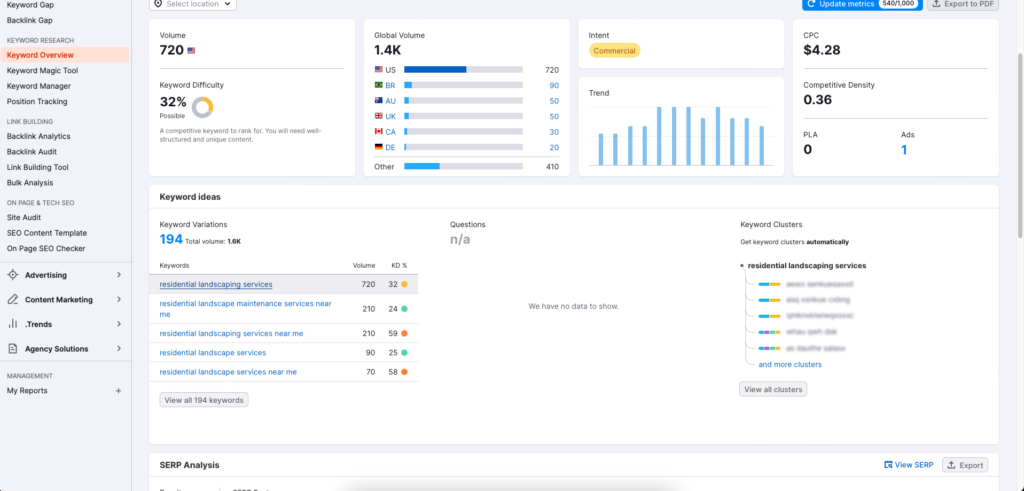Landscape SEO refers to specialized Search Engine Optimization strategies tailored for the landscaping industry. It’s a niche like car rental seo approach to SEO focusing on businesses that offer landscaping services, garden design, lawn care, and other outdoor services. The aim is to increase the online visibility of these businesses, attract more relevant traffic to their websites, and ultimately, drive more leads and customers interested in landscaping services.
Importance of Landscape SEO in 2024
- Local Business Focus: Many landscaping businesses serve specific geographic areas. SEO helps them appear in local search results, which is crucial since most customers search for services like landscaping locally.
- Visual Appeal: Landscaping is highly visual. Landscape SEO strategies can optimize image-heavy websites to load quickly and appear in image search results, attracting more potential customers.
- Seasonal Trends: Landscaping services often have peak seasons. Effective Landscape SEO can ensure a business ranks highly in search results precisely when people are most likely to need their services.
- Competition: The landscaping industry often has many local competitors. Landscape SEO helps businesses stand out in a crowded market.
- Online Reviews: For many local services, including landscaping SEO, online reviews are crucial. SEO strategies often incorporate reputation management, ensuring positive reviews are prominent.
Industry-Specific Statistics - Local Searches: A significant percentage (e.g., over 70%) of local searches lead to a visit to a business within five miles. This statistic emphasizes the importance of local Landscape SEO for landscaping businesses.
- Mobile Searches: With the increasing use of smartphones, a large portion of searches for local services are conducted on mobile devices. Landscape SEO ensures landscaping websites are mobile-friendly, catering to this trend.
- Conversion Rates: Websites optimized for Landscape SEO typically have higher conversion rates, meaning more website visitors become customers.
Keyword Strategy for Landscaping SEO

- Research and Identify Keywords: Utilize tools like Google Keyword Planner, SEMrush, or Ahrefs to research keywords relevant to landscaping. Focus on terms that your potential customers are likely to use when searching for landscaping services.
- Analyze Competitors: Investigate the keywords your competitors are ranking for. This can provide insights into effective keywords in your industry.
- Consider Search Intent: Understand the intent behind the keywords – whether users are seeking information, looking to purchase services, or comparing options.
- Integrate Various Keyword Types: Use a mix of broad and long-tail keywords. Broad keywords might be “landscaping services,” while long-tail keywords could be “residential landscaping services in [Location].”
- Use Local SEO Keywords: If your business is location-specific, include local Landscape SEO keywords, such as the name of your city or region.
- Leverage NLP and Semantic Keywords: Incorporate Natural Language Processing (NLP) and semantic keywords that are contextually related to landscaping, enhancing content relevance for search engines.
- Voice Search Optimization: With the rise of voice search, include conversational, natural-sounding phrases that people might use in voice queries.
Website On Page SEO Optimization for Landscape SEO
Website On-Page SEO Optimization is a critical aspect for any business, including those in the landscaping industry, to enhance their online visibility. The goal is to make your website more attractive and understandable to search engines, which can lead to higher rankings in search results. Here’s a breakdown of key elements to focus on:

1. Optimizing Meta Titles
Meta titles are the titles of a web page that appear in search engine results. They are crucial for SEO as they give search engines and users a brief overview of the content of the page.
- Include Primary Keywords: Ensure your main keyword for the page (e.g., “landscaping services in [Location]”) is included in the meta title.
- Be Concise and Clear: Keep your titles under 60 characters to ensure they display properly in search results.
- Make Them Engaging: Write titles that are appealing and encourage users to click through to your website.
2. Crafting Effective Meta Descriptions
Meta descriptions provide a summary of the web page content. While they don’t directly influence rankings, they impact click-through rates (CTR).
- Include Keywords: Use relevant keywords naturally within the description.
- Be Descriptive and Compelling: Aim for about 155 characters, giving enough detail to entice readers while keeping it brief.
- Call to Action: Include a call to action, encouraging users to click to learn more.
3. On-Page Content Optimization
The actual content on your web pages is fundamental to Landscape SEO. It must be relevant, high-quality, and optimized for both users and search engines.
- Keyword Usage: Use relevant keywords throughout your content, but avoid keyword stuffing. Aim for natural inclusion of keywords.
- Content Quality: Provide valuable, informative, and engaging content. For landscapers, this could include tips, project showcases, services offered, etc.
- Headings and Subheadings: Use H1, H2, and H3 tags effectively to organize content. Include keywords in these headings where appropriate.
4. URL Structure
The structure of your website’s URLs plays a role in Landscape SEO.
- Keep URLs Short and Descriptive: Use URLs that are easy to read and include keywords. For example, use /residential-landscaping-services instead of /service1.
- Use Hyphens to Separate Words: This makes URLs easier to read.
- Avoid Excessive Parameters: URLs with many parameters can be difficult for search engines to crawl.
Additional Tips
- Image Optimization: Use descriptive file names and alt tags for images.
- Internal Linking: Link to other pages within your website where relevant. This helps search engines understand the structure of your site and distribute page authority across pages.
- Mobile-Friendly Design: Ensure your website is responsive and loads quickly on mobile devices.

Setting Up a Google My Business Profile: landscaping Local SEO
Google My Business (GMB) is a free tool that allows businesses to manage their online presence across Google, including Search and Maps. For landscapers, having an optimized GMB profile is essential for local Landscape SEO.
Steps to Set Up GMB:
- Create or Claim Your Business Listing: Go to the Google My Business website and either claim your existing business listing or create a new one.
- Verification: Verify your business. Google usually does this through a postcard sent to your business address with a verification code.
- Complete Your Profile: Fill out all relevant information, such as business name, address, phone number, service areas, business hours, and category (e.g., landscaping or gardening services).
- Add Photos: Include high-quality images of your work, team, and equipment. This visual aspect is particularly important for landscaping businesses.
- Regular Updates: Keep your GMB profile updated with the latest information, posts, and offers.
Managing Local Citations and Reviews
Local citations are mentions of your business on other websites, such as local directories, and they play a key role in local Landscape SEO.
Managing Citations:
- Consistency: Ensure your business name, address, and phone number (NAP) are consistent across all platforms.
- Relevant Directories: List your business in local and industry-specific directories.
Managing Reviews:
- Encourage Reviews: Ask satisfied customers to leave reviews on your GMB profile and other relevant platforms.
- Respond to Reviews: Engage with both positive and negative reviews professionally. This interaction demonstrates that you value customer feedback.
Optimizing for Local Search Queries
Optimizing your website and content for local search queries is critical in attracting local customers.
Key Strategies:
- Local Keywords: Use keywords that include your city, region, or other local identifiers in your website content, meta tags, and URLs.
- Localized Content: Create content that resonates with your local audience, such as blog posts about local landscaping challenges or successes.
- Mobile Optimization: Ensure your website is mobile-friendly, as many local searches are performed on mobile devices.
- Local Link Building: Gain backlinks from local businesses, newspapers, and community websites.

Improving Technical Aspects of landscaping SEO Company’s website
Improving the technical aspects of a website is crucial for any business, including a landscaping SEO company, to ensure good search engine rankings and a positive user experience. Key areas to focus on are website mobile responsiveness, speed, and overall performance.
Website Mobile Responsiveness
With the increasing use of smartphones for internet browsing, having a mobile-responsive website is essential.
- Responsive Design: Ensure your website automatically adjusts its layout, images, and content to fit different screen sizes and resolutions. This can be achieved using responsive web design techniques.
- Touch-Friendly Navigation: Make sure all buttons, links, and forms are easy to navigate using a touchscreen.
- Test on Multiple Devices: Regularly test your website on various mobile devices to ensure compatibility and user-friendliness.
Website Speed
Website speed is a critical factor for both Landscape SEO and user experience. Slow-loading websites can lead to higher bounce rates and lower rankings in search engine results.
- Optimize Images: Use compressed images that retain quality to reduce load time.
- Minimize HTTP Requests: Reduce the number of elements (scripts, images, CSS files) that need to be loaded.
- Use Caching: Implement caching to store frequently accessed data, reducing loading times for repeat visitors.
- Choose a Reliable Hosting Provider: Ensure your hosting service offers fast and reliable performance.
Website Performance Optimization
General website performance also impacts SEO and user experience.
- Minify CSS, JavaScript, and HTML: Remove unnecessary characters from your code to reduce its size and improve load times.
- Enable Compression: Use tools like Gzip to compress your web pages for faster network transfers.
- Reduce Redirects: Minimize the use of redirects, as each redirect can cause additional waiting time for the HTTP request-response cycle.
- Leverage Browser Caching: Store some data on the visitor’s browser so it doesn’t have to be reloaded each time they visit your site.
Additional Considerations for a Landscaping SEO Company Website
- SEO-Friendly URL Structure: Use clear, descriptive URLs that reflect the content of the page.
- SSL Certificate: Ensure your site is secure, especially if you handle customer information.
- User Experience (UX): Design your site to be intuitive and easy to navigate.
- Content Quality: Regularly update your site with high-quality, relevant content that is useful to your target audience.

